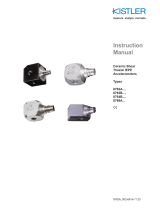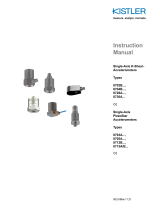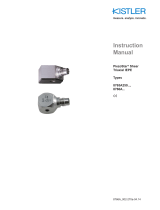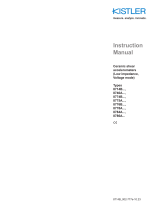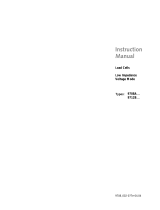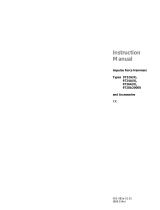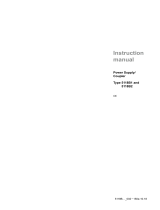Page is loading ...

Instruction
Manual
Impedance Head
Acceleration-Force
Sensor
Type 8770A
ä
002-097e-04.98
(B08.8770Ae)

Pages 1... 25
B08.8770Ae - 04.98
Operating Instructions
Impedance Head Acceleration-Force Sensor
Type 8770A
Your Competent Distributor:
Instrument Corp., 75 John Glenn Drive, Amherst, NY 14228, USA
Phone (716) 691-5100, Fax (716) 691-5226, e-mail [email protected]
Instrumente AG Winterthur, Postfach 304, CH-8408 Winterthur, Switzerland
Phone (052) 224 11 11, Fax (052) 224 14 14, e-mail [email protected]

Type 8770A Impedance Head Acceleration-Force Sensor Page 2
B08.8770Ae-04.98
Contents
Section Page
Contents............................................................................................................................................2
1. Introduction ..................................................................................................................................4
2. Important Guidelines...................................................................................................................4
2.1 For your safety................................................................................................................4
2.2 Precautions.....................................................................................................................4
2.3 Using This Manual..........................................................................................................5
2.4 Impedance Head Type 8770A........................................................................................5
2.5 Manual Nomenclature.....................................................................................................5
3. General Description.....................................................................................................................6
3.1 Supplied Items ................................................................................................................6
4. Technical Information, Functional Description ........................................................................7
4.1 Piezoelectric Measurement Concept..............................................................................7
5. Installation ....................................................................................................................................8
5.1 General ...........................................................................................................................8
5.2 Surface Preparation........................................................................................................8
5.3 Stud Mounting.................................................................................................................8
5.4 Direct Adhesive Mounting...............................................................................................9
5.5 Adapter for Adhesive Mounting.......................................................................................9
5.6 Securing Cables - Typical Sensor Application................................................................10
6. Operation ......................................................................................................................................11
6.1 Powering.........................................................................................................................11
6.1.1 Using “Built In” Power Sources....................................................................................11
6.1.2 Kistler Couplers............................................................................................................11
6.1.3 The Constant Current Power Supply/Coupler.............................................................12
6.1.4 Sensor Power-Up.........................................................................................................14
6.1.5 Overload Recovery......................................................................................................14
6.1.6 Supply Voltage Effects.................................................................................................15
6.2 Driving Long Cables........................................................................................................15
6.3 Ground Loops - Typical Sensor Application ...................................................................17
6.4 Frequency Response Limits ...........................................................................................18
6.4.1 Definition and Frequency Response Standards..........................................................18
6.4.2 High Frequency Limitations .........................................................................................18
6.4.3 Low Frequency Limitations - Transducer ....................................................................20
6.4.4 Low Frequency Limitations - Coupler and Readout Instrumentation ..........................21

Type 8770A Impedance Head Acceleration-Force Sensor Page 3
B08.8770Ae-04.98
7. Maintenance and Calibration......................................................................................................22
7.1 General ...........................................................................................................................22
7.2 Trouble Shooting.............................................................................................................22
7.3 Repairs............................................................................................................................23
7.4 Cleaning..........................................................................................................................23
7.5 Calibration.......................................................................................................................23
8. Accessories..................................................................................................................................24
8.1 Studs...............................................................................................................................24
8.2 Adhesive Mounting Pads................................................................................................24
8.3 Cables.............................................................................................................................24
9. Warranty........................................................................................................................................25

Type 8770A Impedance Head Acceleration-Force Sensor Page 4
B08.8770Ae-04.98
1. Introduction By choosing a Kistler Impedance Head, you have opted for an instrument
distinguished by precision, long life and technical innovation. Please read
these instructions carefully before installing and operating these
instruments.
Kistler offers a wide selection of measuring instruments and comprehensive
systems including:
• Quartz sensors for force, pressure, acceleration, shock,
vibration and strain.
• Associated signal conditioners and accessories.
• Piezoresistive pressure transducers and transmitters with
associated amplifiers.
Kistler can also provide entire systems for special purposes in the
automotive industry, plastics processing, and biomechanics. Our general
catalog provides information on Kistler's products and services. Detailed
technical data sheets are available on most products offered.
Worldwide customer service is at your disposal should you have any
questions regarding this or other Kistler products. Information on your
specific application is also available from Kistler.
2. Important Guidelines
To ensure your personal safety, please observe the safety guidelines in
this section.
2.1 For your safety • Carefully follow the installation information contained in
section 5 of this manual.
• Do not drop the instrument.
• Store in the case provided and in a clean, dry environment.
• Power the instrument in accordance with the instructions in
section 6 of this manual.
2.2 Precautions
Kistler's sensors are thoroughly tested before leaving the factory. To
maintain safe and reliable operation, it is important to follow the
instructions herein.
• Do not mount sensors on high voltage surfaces.
• Keep cable clear of power lines and open machinery.
• Never operate or store the unit beyond the specified
temperature range.
• Do not exceed the maximum specified current.
• Never exceed the maximum specified voltage.

Type 8770A Impedance Head Acceleration-Force Sensor Page 5
B08.8770Ae-04.98
• Follow the instructions for mounting. Do not over tighten.
• Do not expose the unit to excessive shock, i.e., by using a
hammer or dropping the unit.
• When not in use, store the impedance head in the container
supplied. Always store in a clean, dry area.
• Keep the connectors clean and covered when not in use
• Follow the recommendations in Section 7.4
2.3 Using This Manual
Information contained herein includes a technical description, installation
and operating instructions, powering and considerations for cable length.
Section 8 contains a listing of mounting accessories and cables available
to assist with your measurement needs.
It is recommended that the entire manual be read prior to installation and
operation of Impedance Head sensors. The user who has prior experience
with PiezotronÜ type sensors may want to confine reading to particular
sections of interest.
We have endeavored to arrange these instructions in a manner that
allows for easy location of topics of interest. Your Kistler representative is
also available to assist with any questions.
Information contained herein may be subject to change.
2.4 Impedance Head Type 8770A
This manual is applicable to all Impedance Head sensors listed on the title
page. It can also be used as a general guideline for many Kistler
piezoelectric, low impedance sensors.
2.5 Manual Nomenclature
Throughout this manual some special designations and nomenclature are
used for specific terms and concepts relating to piezoelectric sensors.
These are explained in Table 1.
Term Definition
FS Full-Scale
pC picoCoulomb, unit of electrical charge equivalent to 1 X 10-12
Coulomb
low impedance
Internal conversion of charge to voltage output reducing
noise effects
Table 1: Manual Nomenclature

Type 8770A Impedance Head Acceleration-Force Sensor Page 6
B08.8770Ae-04.98
3. General Description
The Kistler Impedance Head sensor is an acceleration and force measuring
instrument. Mechanical impedance can be derived directly from the
measurements made with this device. The output signals are low impedance,
voltage mode, therefore no charge amplifier or special cabling is necessary.
Independent channel outputs are available with sensitivities in units of mV/g
and mV/lb..
Being a low impedance device, no charge amplifier or special cabling is
required and transmission over long lines is possible with a minimum of
noise pick-up.
3.1 Supplied Items
A rigid attachment of the Impedance Head to the test structure is required.
Typically the sensor is attached to a test article on its force side and a
stinger is connected between the acceleration side and a vibration shaker.
An appropriate stud and adhesive mounting plate are supplied for this
purpose. See example below.
Figure 1: Impedance Head Mounting Example

Type 8770A Impedance Head Acceleration-Force Sensor Page 7
B08.8770Ae-04.98
4. Technical Information, Functional Description
4.1 Piezoelectric Measuring Concept
Contained within the impedance head housing is a miniature electronic
circuit. This circuit converts the high impedance charge signals generated
by the piezoelectric elements into low impedance voltage output signals
with an output impedance typically below 100 Ohms.
The integral impedance converters are powered by an external power
source (coupler) that uses a coaxial cable between the sensor and
coupler. The signal and power share a common line. The coupler
provides a constant current source to the sensors and decouples the DC
bias (see Section 6.1.3) from the measuring instrument. The useful signal
is seen as a varying voltage over an 11 VDC (nominal) bias.
Low impedance sensors are ideally suited for applications where long or
moving cables are required or in high humidity or other contaminated
atmospheres. They eliminate the problems associated with high
impedance output by providing a voltage signal with low impedance and a
high frequency response.
Figure 2: Impedance Head Measuring Chain
1. Low impedance (voltage output) impedance head
2. Coaxial cable (Two required)
3. Coupler (constant current supply) or dual mode amplifier
(Two Channels required)
4. Output Cable (Two required)
5. Readout or analysis equipment

Type 8770A Impedance Head Acceleration-Force Sensor Page 8
B08.8770Ae-04.98
5. Installation
5.1 General
For proper operation of Impedance Head sensors, care must be taken
during the installation process. Careful installation will result in optimal
high frequency response, accuracy and reliability.
5.2 Surface Preparation
A smooth, flat surface is necessary for both stud and adhesively mounted
Impedance Head sensors. If the surface is not completely flat, the
coupling between the Impedance Head and the test article introduces
distortion into the measurement. A rough surface creates voids between
the mounting surfaces that reduce high frequency transmissibility. If the
test article does not allow for alterations of the structure’s surface, an ad
mounting pad can be used. A slight reduction in frequency response can
be expected.
For optimum frequency response, the surface and hole preparation
should be according to the instructions in Table 3. The roughness should
not exceed 32 microinches (0.8 micrometers).
5.3 Stud Mounting
Impedance Head type 8770A is specifically designed for stud mounting.
Most Kistler mounting studs are machined from Beryllium Copper for high
strength and low modulus of elasticity, coupled with high elastic limits.
The following guidelines should be followed when stud mounting sensors:
1. Drill and tap an adequate hole to ensure a flush mount of the
sensor. Make sure the stud does not bottom out. A chamfer
should be machined at the top of the mounting hole to ensure
that the base of the sensor makes full contact with the
mounting surface (See Table 3 and Section 8.1).
2. Completely clean the surface prior to mounting.
3. Apply a thin coat of silicon grease to both the sensor and
mounting surface.
4. Always use the proper sockets and a torque wrench when
installing sensors. Tighten the sensor to the torque specified
on the individually supplied calibration certificate or as
specified in Table 2. Do Not Over Tighten.
in-lbs Nm Type
18 ±2 2 ±0.2 8770A.
Table 2: Recommended Mounting Torque

Type 8770A Impedance Head Acceleration-Force Sensor Page 9
B08.8770Ae-04.98
Stud Type D L1 mm L2 mm
8402 10-32 UNF 4.0 8.0
8410 10-32 UNF 4.0 8.0
Table 3: Stud Mounting Preparation
5.4 Adhesive Mounting
Some Impedance Head sensors are specifically designed for adhesive
mounting and require no special mounting adapters. Units furnished with
stud holes can also be used with adhesives.
The surface should be smooth and flat. A cyanoacrylate type adhesive
such as Eastman 910, Loctite 496, super glue is recommended. While
epoxies can also be used, cyanoacrylate adhesives provide an extremely
thin bond providing optimal frequency response.
When adhesive mounting an impedance head with a tapped hole, make
sure that no adhesive is allowed to enter the hole. This could make stud
mounting difficult or impossible at some future time.
Remove the sensor with a manufacturer's recommended adhesive
solvent. Acetone is effective for the removal of cyanoacrylate adhesives.
Use the proper size wrench to twist the sensor loose and break-off the
adhesive. Do Not Impact!
5.5 Adapter for Adhesive Mounting
An adhesive mounting pad is recommended when adhesive mounting
stud-mount sensors. The pad will cause some loss in high frequency
transmissibility and adds mass to the test article.
The pad is manufactured from aluminum with a hard anodized finish. It
should be secured to the test article surface with an adhesive and then
the sensor should be attached to the pad with a stud. In addition to
providing a means of adhesive mounting, the mounting pad provides
ground isolation. Use pad type 8436 for the 8770A sensor.

Type 8770A Impedance Head Acceleration-Force Sensor Page 10
B08.8770Ae-04.98
5.6 Securing Cables - Typical Sensor Application
Figures 3 and 4 show the correct and incorrect ways for installing cables.
Allow a sufficient radius to ensure a proper strain relief. The actual radius
will depend on the cables being used. It is recommended that cables be
secured to the vibrating surface to minimize cable and connector fatigue
failures. Secure cables with a cable clamp. Tape is acceptable on
temporary installations. See Section 8.3 for information on cables
available from Kistler.
Figure 3: Correct Cable Strain Relief
Figure 4: Incorrect Cable Strain Relief

Type 8770A Impedance Head Acceleration-Force Sensor Page 11
B08.8770Ae-04.98
6. Operation
Piezoelectric sensors are self generating transducers. While the piezoelectric
sensor does not require an external power source, it is necessary to provide
power to the internal electronic impedance converter. This section is intended
to provide the user with the information necessary to ensure accurate
measurements with Impedance Head sensors. Topics to be covered include
powering, signal conditioning, frequency response and driving long cables.
6.1 Powering
6.1.1 Using “Built In” Power Sources
Many FFT analyzers and vibration monitors are available with internal
power supplies. Often identified as "ICP" or "Constant Current Sources",
these internal power supplies are generally compatible with Kistler
Impedance Head sensors.
Before using the built-in power source, compare the measurement
instrument current source specifications with the current and voltage
specifications of the impedance to be used. If the instrument power is
within the range required by the sensor there should be no problem with
compatibility. If the user plans to drive long cables (over 430 feet/130 m)
the guidelines in Section 6.2 should be followed. The impedance head
low frequency response may be affected by the input impedance of the
measuring instrument as discussed in Section 6.4.4.
Caution: Many industrial monitors have adjustable current controls.
Exceeding the maximum current rating of any sensor may cause
permanent damage and void the warranty.
6.1.2 Kistler Couplers
Kistler offers a comprehensive line of power supply/couplers and dual mode
amplifiers. If the user is utilizing these instruments, they are designed for
compatibility with Impedance Head sensors. The chart below provides a
listing of available power supply/couplers. Please request data sheets on
specific models.
Type 5108 Passive coupler. Customer provides power.
Type 5114A Battery powered or AC-DC adapter single channel coupler. Meter monitors
bias and battery condition.
Type 5118B Battery and AC-DC Adapter powered single channel coupler with LEDs to
monitor bias. Plug-in filters available.
Type 5120 AC powered single channel coupler with AC/DC output coupling. Meter
monitors bias and offset. Factory adjustable gain and optional low pass
filters.
Type 5124A/A1
5126A/A1 Line powered, rack mounted, 12 and 6 channel couplers. A1 version offers
internally adjustable gain and optional plug-in filters.
Type 5134A 4-channel AC powered coupler and amplifier. Selectable high pass filters
and gain. Random noise generator for testing with FFT analyzer. Remote
control and sensing via RS-232C. CE certified.
Type 5350 Transducer simulator for trouble shooting or checking system performance.
It provides an ideal means to confirm transducer location or detect
inoperative cables. Connects directly to the input of any Kistler coupler or
any ICP compatible power source. Output frequencies of 100 Hz or 1000
radians/second, sine or square wave with adjustable amplitude.
Table 4: Kistler Coupler/Power Supplies and Accessories

Type 8770A Impedance Head Acceleration-Force Sensor Page 12
B08.8770Ae-04.98
6.1.3 The Constant Current Power Supply/Coupler
To better understand the purpose of the current source, a review of the
Piezotron impedance converter is in order. Figure 5 is a simplified
schematic diagram of a piezoelectric system. When excited, the quartz
element produces a charge proportional to the measurand. The resultant
voltage(developed across Cr in Figure 5) is applied to the input of the
internal impedance converter (Electrometer Amplifier). The impedance
converter will produce an output voltage that follows the input faithfully.
Figure 5: Simplified Diagram of Piezoelectric Low Impedance System
The source resistor (Rs), while located in the coupler, is a part of the
source follower circuit. In order for the Piezotron to provide enough gain,
Rs must have a high dynamic resistance while being able to provide
enough current (low DC resistance) as not to affect the high frequency
response of the system. Replacing Rs with a constant current diode
(Figure 6) provides a device with a high dynamic resistance while allowing
sufficient current to flow.
Figure 6: Schematic Diagram Of A Simple Coupler

Type 8770A Impedance Head Acceleration-Force Sensor Page 13
B08.8770Ae-04.98
Figure 6 (previous page) shows a schematic of a simple power
supply/coupler. DC power is supplied from a 24 volt source such as a
regulated power supply or batteries. One advantage of the Piezotron
system is the fact that a simple two wire coaxial cable is used for both
power and signal. Because the signal and power both share the same
line, it is necessary to include the capacitor C to decouple (or block) the
DC from the measurement instrument input.
Operating within the voltage range of 20...30 VDC assures a full
undistorted ±5 Volt output amplitude (See Figure 7A). If the source
voltage is reduced, distortion and clipping of the signal will occur if one
attempts to use the full amplitude range of the Impedance Head (See
Figure 7B). The following equations are provided to calculate the
maximum full scale voltage available when operating with a reduced
voltage.
Maximum positive amplitude:
+= −−
F
s
E
s
E
b()1
Maximum negative amplitude:
−= −Fs Eb 2
Where:
Fs
Es
Eb
= Full scale output voltage (peak).
= DC supply voltage (sometimes called compliance voltage).
= bias voltage (from calibration certificate).
2-3V Required by
current limiting circuit
28V(E
s
)
E
b
0V
Impedance Converter
cannot go below 2-3V
Figure 7A: Output Signal When Operated With 28V Supply

Type 8770A Impedance Head Acceleration-Force Sensor Page 14
B08.8770Ae-04.98
Low Supply
Voltage Distortion and
Clipping Occurs
E
b
Figure 7B: Example of Output Distorting and Clipping when Supply Voltage is Low
6.1.4 Sensor Power-Up
When power is first applied to the sensor, (through an AC coupled
coupler) a voltage will appear at the output of the coupler (See Figure 8A).
As the coupling capacitor discharges, the DC output, from the coupler will
drop to zero Volts. This "settling time" is equal to 5 times the time constant
of the coupler employed. Allow time for the unit to "settle" before making
measurements.
6.1.5 Overload Recovery
Whenever the impedance converter is driven by a signal exceeding the
normal operating range, certain components will become non operational.
During this non operational state, the amplifier components are protected
from overload damage. The amount of time required for recovery from an
overload depends on several factors. Important for overload recovery
time is the size of the overload. As with power-up, the time constant
makes the biggest contribution to the recovery time. Figure 8B illustrates
a typical overload and recovery sequence.
Figure 8A: Behavior Of Output
Signal During Power-Up
Figure 8B: Output Behavior
During Overload and Recovery

Type 8770A Impedance Head Acceleration-Force Sensor Page 15
B08.8770Ae-04.98
6.1.6 Supply Voltage Effects
Long-term fluctuations in the power supply level between 24 and 30 volts
can be tolerated. The sensitivity shift caused by such deviation is less
than 0.05%/Volt. A normal noise level is maintained if the power supply
ripple is 25mV RMS or less. The polarity must be maintained throughout
the system since applying reversed polarity power may cause damage to
the Impedance Head.
6.2 Driving Long Cables
The voltage mode Piezotron circuit allows for long cable runs with low noise
susceptibility. Most laboratory instruments with built-in ICP power provide
current in the range of 2 to 4 mA. Most Kistler couplers are set at the factory
to provide 4mA of source current. 4mA is a good compromise value for
maximum frequency response and high reliability.
Assuming a cable capacitance of 30pF/foot(98 pF/m), the full frequency
range of Impedance Head sensors can be realized (±5 Volt output) up to a
length of 430 feet (130 meters) with 4 mA of drive current. Most Kistler
cable types and common RG58 coaxial cable have a rated capacitance of
30 pF/foot (98 pF/m). For most laboratory applications this is quite
adequate.
As cable length is increased the cable capacitance becomes significant,
thereby loading the Piezotron impedance converter. If the current is not
sufficient to charge the cable at an adequate rate, high frequency
distortion will be experienced. The solution to this problem is to increase
the drive current
For the user's convenience a chart is provided (See Table 5). The values
given are based on a cable capacitance of 30 pF/foot (98 pF/m). The list
of cables available from Kistler can be found in Section 9.3. All cables in
this section are 30pF/ft (98 pF/m). except for the 1631, 1635 and 1639
which are 20 pF per foot(65 pF/m).
Maximum
Frequency +/- 5%
Cable Length Ft
(meters)
Current (mA) Required
For Output Signal
+/- 1 Volt
Current (mA) Required
For Output Signal
+/- 5 Volts
10 kHz 1000 (300) 2 10
2000 (600) 4 18
9 kHz 1000 (300) 2 9
2000 (600) 4 17
8 kHz 1000 (300) 2 8
2000 (600) 3 15
7 kHz 1000 (300) 2 7
2000 (600) 3 14
6 kHz 1000 (300) 2 6
2000 (600) 3 12
5 kHz 1000 (300) 2 5
2000 (600) 2 10
♦ Based on 30 pF/ foot (98 pF/meter)
Table 5: Current Requirements for Driving Long Cables

Type 8770A Impedance Head Acceleration-Force Sensor Page 16
B08.8770Ae-04.98
The current requirements can be calculated using the following equation:
I
f
CE=2
π
Where:
I
f
C
E
= Current in Amperes
= Frequency in Hz
= Capacitance in Farads
= Output in Volts, Peak
Never use more current than required to make the desired
measurement. Never exceed the maximum current.
If a requirement calls for 1,000 feet (300m) of cable and the maximum
frequency of interest is only 5 kHz than the user should select (From
Table 5) 5 mA of current rather than the 10 mA required for the full 10 kHz
range. As current is increased, the noise produced by the Piezotron
circuit will also increase. The miniature Piezotron amplifier will produce
more heat as current is increased resulting in reduced life and reliability.
The specified maximum temperature range (in the data sheet) is based on
4 mA of supply current. It is necessary to degrade the maximum
operating temperature when operating under increased temperature
conditions. The graph in Figure 9 shows the approximate maximum
temperature vs. operating current.
Figure 9: Maximum PIEZOTRON Current as a Function of Operating Temperature
The equation for computing the maximum current for a specific
temperature is:
I
t
max max
.( )=−016 150
where:
I = Current in mA
t = Temperature is °C

Type 8770A Impedance Head Acceleration-Force Sensor Page 17
B08.8770Ae-04.98
6.3 Ground Loops - Typical Sensor Application
The ground loop is one of the most common causes of ground noise. It
will usually manifest itself as unwanted noise occurring at the line
frequency (50 - 60 Hz).
Ground loops occur when current flows between the sensor and
coupler/conditioner grounds. If the coupler ground and the sensor ground
are at exactly the same potential, there will be no ground loop between
these two devices. If the ground potential is different between the sensor
mounting surface and the coupler ground, a slight current will flow causing
a ground loop to occur (See Figure 10). While the amount of current
might seem insignificant, the measurement levels are generally very low
and the ground current will appear on the signal at a measurable level.
There can be many causes of ground loops in a complete measurement
system but the ground path between the sensor and coupler is among the
most common.
Figure 10: Current Path (Loop) Between the Coupler and Sensor Ground
One method used to eliminate ground loops is to isolate the ground of the
sensor from the ground of the test article (See Figure 11).
Figure 11: The Current Path is Broken with the use of a Ground Isolation Pad

Type 8770A Impedance Head Acceleration-Force Sensor Page 18
B08.8770Ae-04.98
6.4 Frequency Response Limits
All sensors have specified frequency limits which are a function of the
mechanical and electrical design. In order to better understand the
measurement process and limitations this section will describe both the
inherent limitations and limitations imposed by the installation, operation and
measurement-analysis instrumentation.
6.4.1 Definition and Frequency Response Standards
Frequency response is defined as a maximum specified amplitude variation,
from an established reference frequency, over a specified bandwidth.
Impedance Head sensors are specified with maximum variations of ±5% to
±10%. Kistler uses the industry standard reference frequency of 100Hz.
Many users may be more familiar with the common frequency response
standard for electronic equipment which is generally ±3dB. In most
mechanical applications an error of ±3db (about ±30%) does not provide the
required accuracy; thus, ±5% (±10% in some cases) is considered a more
useful and accurate limit.
6.4.2 High Frequency Limitations
The inherent high frequency limit of an Impedance Head is a function of its
mechanical characteristics. Impedance Head sensors can be represented as an
undamped single degree-of-freedom spring-mass system. Impedance Heads are
modeled by the classical second order differential equation whose solution is:
a
af
fQ
f
f
o
b
nn
≅
−
+
1
11
22
2
2
Where:
Where:
f
undamped natural resonant
f
requenc
y
Hz
f frequency at any given po of the curve Hz
a output acceleration
a mounting base of reference acceleration f
fn
Q factor of amplitude increase at resonance
n
o
b
=() ()
= ( )
=
=
=
int
=
1

Type 8770A Impedance Head Acceleration-Force Sensor Page 19
B08.8770Ae-04.98
Quartz Impedance Heads have a Q of approximately 10 to 40 and
therefore the phase angle can be written as:
Phase Lag (deg)
of a single degree of freedom system
≅
≤
60 2
5Qf
ffor f
f
nn
Using the basic equation for resonance one can better understand the
basic Impedance Head mechanical system and the affect on high
frequency response.
fk
m
n=1
2
π
The spring constant (k) is determined by the stiffness of the quartz crystal
and preload stud. The mass (m) is the supported part of the Impedance
Head structure. This spring-mass system is the basic component that
converts the input forces into acceleration. As with any single degree-of-
freedom system, a resonance condition will occur (per the above
equation) which causes the sensitivity to increase with frequency.
It is desirable to have a uniform frequency response over the specified
frequency range. As can be seen, (Figure 12), the sensitivity greatly
increases when approaching resonance. About a 5% amplitude rise can
be expected at 9/40 of the resonant frequency. It is possible to operate
above the maximum specified frequency by applying the appropriate
correction factors, or filtering to compensate for the resonant rise in
response.
Figure 12: Typical Frequency Response of a Piezoelectric Sensor
Section 5 provides important information regarding mounting. It is important
that these instructions are followed to ensure optimal transmissibility at high
frequencies. Mounting to rough surfaces, using soft adhesives and magnetic
mounts will limit the high frequency range to some value lower than the
specified frequency range.
/

